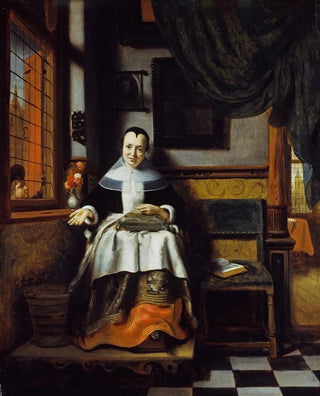Art print | The Virtuous Woman - Nicolaes Maes


View from behind

Frame (optional)
In the rich and varied landscape of 17th-century Dutch art, the "L virtuous woman" art print by Nicolaes Maes stands out for its ability to capture the very essence of domestic life and the moral values of its time. This canvas, imbued with realism and delicacy, invites the viewer to immerse themselves in a universe where every detail tells a story. Through this art print, the artist manages to evoke an intimate atmosphere, where light plays a crucial role, illuminating the serene face of the depicted woman. The scene, both simple and loaded with meaning, questions our perception of virtue and femininity, while transporting us to a suspended moment rich in emotion.
Style and uniqueness of the work
Nicolaes Maes's style is characterized by finesse of execution and particular attention to detail. The "L virtuous woman" art print perfectly illustrates this approach, with soft color nuances and subtle lighting that envelops the subject. Maes, a pupil of Rembrandt, skillfully integrated his master's lessons while developing his own voice, marked by sensitivity to the psychology of characters. In this piece, the artist highlights a woman deep in thought, capturing a moment of intimacy that resonates with the moral concerns of his time. The choice of objects present in the composition, such as the book and domestic elements, reinforces the idea of virtue, while offering us a glimpse into the bourgeois values of 17th-century Dutch society. Each brushstroke demonstrates exceptional technical mastery, while the balanced composition invites contemplation.
The artist and his influence
Nicolaes Maes, born in 1634 in Dordrecht, is often regarded as one of the most representative artists of the Dutch Golden Age. His career, spanning several decades, is marked by a notable stylistic evolution, shifting from historical painting to more intimate genre scenes. Maes captured the spirit of the times, brilliantly translating the concerns of his era through his works. His influence is felt not only among his contemporaries but also among the artists who follow him.

Matte finish

View from behind

Frame (optional)
In the rich and varied landscape of 17th-century Dutch art, the "L virtuous woman" art print by Nicolaes Maes stands out for its ability to capture the very essence of domestic life and the moral values of its time. This canvas, imbued with realism and delicacy, invites the viewer to immerse themselves in a universe where every detail tells a story. Through this art print, the artist manages to evoke an intimate atmosphere, where light plays a crucial role, illuminating the serene face of the depicted woman. The scene, both simple and loaded with meaning, questions our perception of virtue and femininity, while transporting us to a suspended moment rich in emotion.
Style and uniqueness of the work
Nicolaes Maes's style is characterized by finesse of execution and particular attention to detail. The "L virtuous woman" art print perfectly illustrates this approach, with soft color nuances and subtle lighting that envelops the subject. Maes, a pupil of Rembrandt, skillfully integrated his master's lessons while developing his own voice, marked by sensitivity to the psychology of characters. In this piece, the artist highlights a woman deep in thought, capturing a moment of intimacy that resonates with the moral concerns of his time. The choice of objects present in the composition, such as the book and domestic elements, reinforces the idea of virtue, while offering us a glimpse into the bourgeois values of 17th-century Dutch society. Each brushstroke demonstrates exceptional technical mastery, while the balanced composition invites contemplation.
The artist and his influence
Nicolaes Maes, born in 1634 in Dordrecht, is often regarded as one of the most representative artists of the Dutch Golden Age. His career, spanning several decades, is marked by a notable stylistic evolution, shifting from historical painting to more intimate genre scenes. Maes captured the spirit of the times, brilliantly translating the concerns of his era through his works. His influence is felt not only among his contemporaries but also among the artists who follow him.






